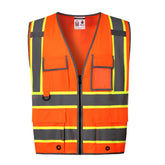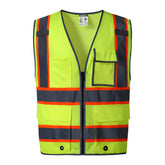What is a Safety Jacket?
A safety jacket is a piece of high-visibility (hi-vis) clothing designed to make the wearer stand out in low-light or high-risk environments. It is commonly used by construction workers, road crews, cyclists, warehouse staff, and emergency responders. By combining fluorescent colors with reflective materials, a safety jacket ensures that individuals remain visible to others, reducing the risk of accidents.
Why and When You Need a Safety Jacket
You need a safety jacket whenever visibility is critical to safety. Typical situations include:
-
Construction sites – Workers are surrounded by heavy machinery and vehicles.
-
Roadwork and traffic control – To prevent collisions near highways or busy roads.
-
Cycling, running, or walking at night – For personal safety on streets.
-
Emergency response – Police, firefighters, and paramedics need visibility in chaotic or low-light situations.
-
Industrial workplaces – Forklifts and equipment make visibility vital for accident prevention.
In short, a safety jacket protects you by making sure others can see you clearly.
How to Choose the Right Safety Jacket
When selecting a safety jacket, consider the following factors:
-
Work environment – Roadside work, off-road warehouses, or emergency response each require different safety ratings.
-
Type and Class (ANSI/ISEA 107 Standard) – Choose the correct type (O, R, or P) and visibility class (1, 2, or 3) required for your job.
-
Weather protection – Insulated jackets for winter, breathable mesh for summer, waterproof jackets for rain.
-
Comfort and fit – A jacket should not restrict movement but must stay securely in place.
-
Durability – Look for quality stitching and resistant materials that can withstand harsh environments.
(According to OSHA’s high-visibility clothing guidelines selecting the correct type and class of safety jacket is essential for compliance and worker safety.)
Understand Types of Safety Jacket (ANSI/ISEA 107)
The ANSI/ISEA 107-2020 standard defines three types of safety jackets based on work environment:
-
Type O (Off-Road)
-
For workers in areas without public traffic.
-
Common in warehouses, oil fields, airports, and mines.
-
Only covers Class 1 visibility.
-
-
Type R (Roadway and Traffic Control)
-
For workers exposed to moving traffic or roadside work.
-
Includes construction crews, surveyors, utility workers.
-
Can be Class 2 or Class 3, depending on visibility needs.
-
-
Type P (Public Safety)
-
Designed for emergency responders such as police, firefighters, and paramedics.
-
Often requires Class 2 or Class 3 for maximum visibility.
-
Classes of Safety Jacket
Along with types, jackets are divided into classes based on visibility level:
-
Class 1
-
Lowest visibility requirement.
-
For workers away from traffic or only exposed to vehicles moving less than 25 mph (e.g., parking attendants, warehouse staff).
-
-
Class 2
-
Higher visibility, with more reflective material.
-
Required for roadwork, traffic control, and areas with vehicles moving 25–50 mph.
-
-
Class 3
-
Maximum visibility, with reflective material on torso, arms, and legs.
-
Required for high-speed roadways, nighttime work, and emergency responders in dangerous conditions.
-
Purposes of a Safety Jacket
The main purpose of a safety jacket is protection through visibility, but it also serves additional functions:
-
Reduces accidents by making workers visible to drivers and machine operators.
-
Provides weather protection (insulated, rainproof, or breathable).
-
Offers specialized safety features, such as flame resistance or chemical protection.
-
Helps in team identification during emergencies or large projects.
-
Ensures compliance with safety regulations (ANSI/ISEA in the U.S., EN ISO standards in Europe).
Conclusion
A safety jacket is not just clothing—it is life-saving equipment. By choosing the correct type (O, R, P) and class (1, 2, 3) for your work environment, you ensure maximum visibility and protection. Whether you are on a construction site, near traffic, or responding to an emergency, the right safety jacket helps you stay seen and safe.





